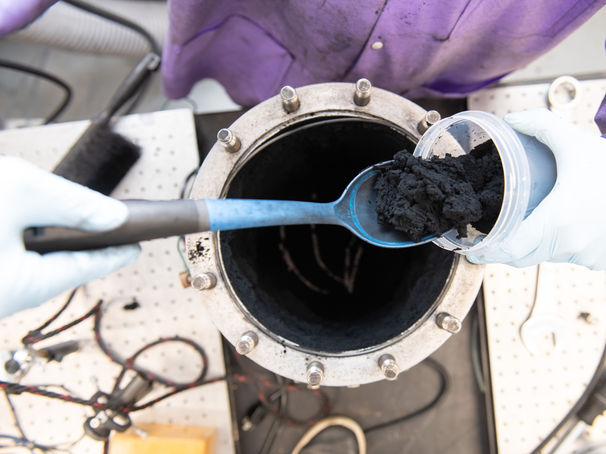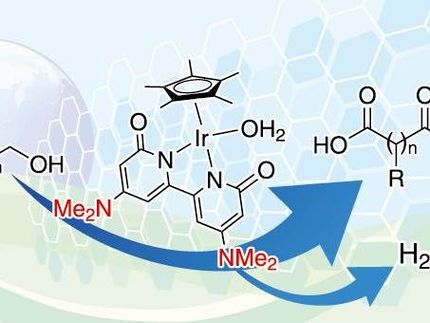A big bang: Graphene, hydrogen research leads to new company
A simple new way to create graphene
Advertisement
It's a true research success story: Explosive graphene and hydrogen research from Kansas State University has turned into a successful international company, HydroGraph Clean Power Inc. The company recently went public on the Canadian Securities Exchange and is preparing for decades of growth as an important research and development hub.

A Kansas State University researcher scoops out large quantities of graphene from a small detonation chamber. A K-State-patented method of creating graphene involves putting acetylene and oxygen in a small chamber and creating a controlled detonation.
Kansas State University
HydroGraph and the K-State research involve a simple new way to create graphene: Put acetylene and oxygen in a small chamber and create a controlled detonation that produces large amounts of graphene from a single spark.
Graphene is a single atom-thick, two-dimensional sheet of hexagonally coordinated carbon atoms, which makes it the world's thinnest material and gives it valuable physical and electronic properties. Graphene has numerous applications, such as augmenting high-strength metals, reinforcing concrete, enhancing biomaterials and revolutionizing electronic applications.
The K-State detonation method of creating graphene checks all the right boxes. The process is safer, cleaner, environmentally friendly, cheaper, consistent and faster than other methods. An added bonus is that it is also scalable and can produce high-quality graphene in mass quantities.
"We discovered graphene serendipitously in the lab when we were using controlled explosions to make an aerosol gel," said Chris Sorensen, Cortelyou-Rust university distinguished professor of physics and university distinguished teaching scholar. "I wasn't expecting to make graphene."
Sorensen's research team had spent several years developing and patenting aerosol gels, but one day found that their explosion synthesis method also could produce nanographene — a dark and incredibly lightweight material. Several years ago, the Kansas State University Research Foundation patented Sorensen's new detonation technique to mass-produce graphene.
Sorensen's work caught the eye of Harold Davidson and Barry Hemsworth, entrepreneurs from Vancouver, British Columbia. Davidson reached out in 2017 to start a collaboration with Sorensen to build up and automate the graphene-making process to an industrial scale. Davidson and Hemsworth created a start-up company called Carbon-2D Graphene Inc. and worked hard to procure venture capital for Carbon-2D to fund Sorensen's research.
The investment paid off. The research not only led to a pilot-scale graphene production device, but another discovery: an environmentally benign, inexpensive method to make hydrogen. This is a significant advancement because hydrogen will be an important energy source in the near future, Sorensen said.
Carbon-2D Graphene Inc. soon became HydroGraph Clean Power Inc. and the collaboration has expanded to involve other K-State researchers and Kjirstin Breure, who became HydroGraph's chief operating officer. The work has resulted in new inventions, intellectual property and endless possibilities.
"We believe in partnerships and the partnership we have with K-State has been very productive," Davidson said. "The world of nanomaterials is going to open up to us and the process we have. We're using digital methods with our precisely controlled detonation technology, in order to create what we feel are going to be the nanomaterials required for the fourth industrial revolution."
Sorensen soon engaged Stefan Bossmann, university distinguished professor emeritus of chemistry, to assist in the chemical side of the collaboration. Bossmann applied a mild oxidation method to the graphene to make a high-quality graphene oxide, which maintains the integrity of the graphene and creates a new material with numerous possibilities.
"Our process is completely novel and our surface modification methods are ultraprecise," Bossmann said. "We use the explosion graphene and we modify only the outer layer, which means we maintain all other layers and their properties. That's enough to connect this outer layer to virtually any other matrix through well-established organic and inorganic chemistry."
The team of researchers also includes Arjun Nepal, research assistant professor of physics; Stephen Corkill, research engineer in physics; and numerous graduate students and undergraduate students.
Some of the recent patents from the collaborative research team include:
- A method to create hydrogen-rich syngas in a provisional patent titled "Process for synthesis of syngas components."
- A device for upscaling graphene production in a patent application titled "Device and process for mass production of particulate materials."
- A process for developing turbostratic graphene oxide in a patent application titled "Graphene/graphene oxide core/shell particulates and methods."
HydroGraph continues to support the team, and recently established a $1.4 million research partnership for future projects that involve other K-State researchers in the Carl R. Ice College of Engineering and College of Arts and Sciences: Placidus Amama, associate professor of chemical engineering; Suprem Das, assistant professor of industrial and manufacturing systems engineering; Jun Li, professor of chemistry; and Dong Lin, associate professor of industrial and manufacturing systems engineering.
Other collaborators on the work include the University of Kansas Medical Center and Missouri University of Science and Technology. The funding and research will train nine graduate students.
"This research and commercialization partnership with HydroGraph is an excellent example of how K-State is actively working with companies to bring new businesses and jobs into the state of Kansas," said David Rosowsky, K-State vice president for research.
The multi-institutional research team continues to further expand on the detonation method to create graphene and hydrogen-rich syngas. They also are developing devices for more efficiently producing the unique graphene and graphene oxide. It's a collaboration with big plans for future growth and development.
"All of this started as curiosity-based research," Sorensen said. "Land-grant universities were founded on the idea that research and creative ideas formulated at the state university would yield useful technologies. That is exactly what happened here. Moreover, this type of intellectual property collaboration could be the future for K-State."
Other news from the department business & finance
Most read news
More news from our other portals
Something is happening in the chemical industry ...
This is what true pioneering spirit looks like: Plenty of innovative start-ups are bringing fresh ideas, lifeblood and entrepreneurial spirit to change tomorrow's world for the better. Immerse yourself in the world of these young companies and take the opportunity to get in touch with the founders.
See the theme worlds for related content
Topic world Synthesis
Chemical synthesis is at the heart of modern chemistry and enables the targeted production of molecules with specific properties. By combining starting materials in defined reaction conditions, chemists can create a wide range of compounds, from simple molecules to complex active ingredients.

Topic world Synthesis
Chemical synthesis is at the heart of modern chemistry and enables the targeted production of molecules with specific properties. By combining starting materials in defined reaction conditions, chemists can create a wide range of compounds, from simple molecules to complex active ingredients.


























































